Tunicate Swarm Algorithm with Deep Learning Based Land Use and Cover Change Detection in Nallamalla Forest India
Abstract
1. Introduction
2. Materials and Methods
2.1. Optimal Feature Extraction
2.2. Image Classificaion Using DBN Model
2.3. Hyper Parameter Tuning Using Truncate Swarm Algorithm (TSA)
- Avoid clashes between every searching agent.
- Every agent is assured of moving towards the optimum individual.
- Make the searching agent converges to the area nearby the optimum individual.
2.3.1. Elude Clashes between Every Searching Agent
2.3.2. Pathfinding to the Optimal Individual
2.3.3. Make the Searching Agent Converge to the Optimal Individual
2.3.4. Swarm Behavior
- Step 1: Initialize the original population of searching agent
- Step 2: Assign value to -iteration and other initial variables.
- Step 3: Calculate the fitness values of every tunicate and choose the individual with the better fitness values as the optimum searching agent.
- Step 4: Upgrade the position of every searching agent using Equation (22).
- Step 5: Keep every search agent in the search space.
- Step 6: Evaluate the fitness values of every upgrade searching agent; if there is the best individual than the preceding optimum searching agent in the population, upgrade
- Step 7: If the maximal iteration is attained, then the procedure stops. Or else, continue with steps 4–7.
- Step 8: Output the better individual .
3. Data and Data Processing
3.1. Study Area
3.2. Satellite Images
4. Results and Discussion
5. Conclusions
Author Contributions
Funding
Data Availability Statement
Conflicts of Interest
References
- Talukdar, S.; Singha, P.; Mahato, S.; Pal, S.; Liou, Y.A.; Rahman, A. Land-use land-cover classification by machine learning classifiers for satellite observations—A review. Remote Sens. 2020, 12, 1135. [Google Scholar] [CrossRef]
- Xu, Y.; Du, B.; Zhang, L.; Cerra, D.; Pato, M.; Carmona, E.; Prasad, S.; Yokoya, N.; Hänsch, R.; Le Saux, B. Advanced multi-sensor optical remote sensing for urban land use and land cover classification: Outcome of the 2018 IEEE GRSS data fusion contest. IEEE J. Sel. Top. Appl. Earth Obs. Remote Sens. 2019, 12, 1709–1724. [Google Scholar] [CrossRef]
- Lenco, D.; Interdonato, R.; Gaetano, R.; Minh, D.H.T. Combining Sentinel-1 and Sentinel-2 Satellite Image Time Series for land cover mapping via a multi-source deep learning architecture. ISPRS J. Photogramm. Remote Sens. 2019, 158, 11–22. [Google Scholar]
- Thepade, S.D.; Dindorkar, M.R. Fusing deep convolutional neural network features with Thepade’s SBTC for land usage identification. Eng. Sci. Technol. Int. J. 2022, 27, 101014. [Google Scholar] [CrossRef]
- Wong, Y.; Lee, H.Y.; Chen, Y.C.; Zeng, Y.T.; Chern, Y.R.; Chen, N.T.; Lung, S.C.C.; Su, H.J.; Wu, C.D. Using a land use regression model with machine learning to estimate ground level PM 2.5. Environ. Pollut. 2021, 277, 116846. [Google Scholar] [CrossRef]
- Helber, P.; Bischke, B.; Dengel, A.; Borth, D. Eurosat: A novel dataset and deep learning benchmark for land use and land cover classification. IEEE J. Sel. Top. Appl. Earth Obs. Remote Sens. 2019, 12, 2217–2226. [Google Scholar] [CrossRef]
- Pan, X.; Wang, Z.; Gao, Y.; Dang, X.; Han, Y. Detailed and automated classification of land use/land cover using machine learning algorithms in Google Earth Engine. Geocarto Int. 2022, 37, 5415–5432. [Google Scholar] [CrossRef]
- Tian, F.; Wu, B.; Zeng, H.; Watmough, G.R.; Zhang, M.; Li, Y. Detecting the linkage between arable land use and poverty using machine learning methods at global perspective. Geogr. Sustain. 2022, 3, 7–20. [Google Scholar] [CrossRef]
- Yoo, S.; Lee, J.; Farkoushi, M.G.; Lee, E.; Sohn, H.G. Automatic generation of land use maps using aerial orthoimages and building floor data with a Conv-Depth Block (CDB) ResU-Net architecture. Int. J. Appl. Earth Obs. Geoinf. 2022, 107, 102678. [Google Scholar] [CrossRef]
- Masolele, R.N.; De Sy, V.; Herold, M.; Marcos, D.; Verbesselt, J.; Gieseke, F.; Mullissa, A.G.; Martius, C. Spatial and temporal deep learning methods for deriving land-use following deforestation: A pan-tropical case study using Landsat time series. Remote Sens. Environ. 2021, 264, 112600. [Google Scholar] [CrossRef]
- Yao, Y.; Yan, X.; Luo, P.; Liang, Y.; Ren, S.; Hu, Y.; Han, J.; Guan, Q. Classifying land-use patterns by integrating time-series electricity data and high-spatial resolution remote sensing imagery. Int. J. Appl. Earth Obs. Geoinf. 2022, 106, 102664. [Google Scholar] [CrossRef]
- Zhang, P.; Ke, Y.; Zhang, Z.; Wang, M.; Li, P.; Zhang, S. Urban land use and land cover classification using novel deep learning models based on high spatial resolution satellite imagery. Sensors 2018, 18, 3717. [Google Scholar] [CrossRef]
- Abdi, A.M. Land cover and land use classification performance of machine learning algorithms in a boreal landscape using Sentinel-2 data. GIScience Remote Sens. 2020, 57, 1–20. [Google Scholar] [CrossRef]
- Zhu, Q.; Guo, X.; Deng, W.; Guan, Q.; Zhong, Y.; Zhang, L.; Li, D. Land-use/land-cover change detection based on a Siamese global learning framework for high spatial resolution remote sensing imagery. ISPRS J. Photogramm. Remote Sens. 2022, 184, 63–78. [Google Scholar] [CrossRef]
- Chang, S.; Wang, Z.; Mao, D.; Guan, K.; Jia, M.; Chen, C. Mapping the essential urban land use in changchun by applying random forest and multi-source geospatial data. Remote Sens. 2020, 12, 2488. [Google Scholar] [CrossRef]
- Talukdar, S.; Singha, P.; Mahato, S.; Praveen, B.; Rahman, A. Dynamics of ecosystem services (ESs) in response to land use land cover (LU/LC) changes in the lower Gangetic plain of India. Ecol. Indic. 2020, 112, 106121. [Google Scholar] [CrossRef]
- Zhang, C.; Sargent, I.; Pan, X.; Li, H.; Gardiner, A.; Hare, J.; Atkinson, M. An object-based convolutional neural network (OCNN) for urban land use classification. Remote Sens. Environ. 2018, 216, 57–70. [Google Scholar] [CrossRef]
- Ekim, B.; Sertel, E. Deep neural network ensembles for remote sensing land cover and land use classification. Int. J. Digit. Earth 2021, 14, 1868–1881. [Google Scholar] [CrossRef]
- Nayak, D.R.; Padhy, N.; Mallick, K.; Zymbler, M.; Kumar, S. Brain Tumor Classification Using Dense Efficient-Net. Axioms 2022, 11, 34. [Google Scholar] [CrossRef]
- Wang, L.; Liu, Z. Data-driven product design evaluation method based on multi-stage artificial neural network. Appl. Soft Comput. 2021, 103, 107117. [Google Scholar] [CrossRef]
- Fang, Z.; Roy, K.; Mares, J.; Sham, C.W.; Chen, B.; Lim, J.B. Deep learning-based axial capacity prediction for cold-formed steel channel sections using Deep Belief Network. Structures 2021, 33, 2792–2802. [Google Scholar] [CrossRef]
- Kaur, S.; Awasthi, L.K.; Sangal, A.L.; Dhiman, G. Tunicate Swarm Algorithm: A new bio-inspired based metaheuristic paradigm for global optimization. Eng. Appl. Artif. Intell. 2020, 90, 103541. [Google Scholar] [CrossRef]
- Cui, Y.; Shi, R.; Dong, J. CLTSA: A Novel Tunicate Swarm Algorithm Based on Chaotic-Lévy Flight Strategy for Solving Optimization Problems. Mathematics 2022, 10, 3405. [Google Scholar] [CrossRef]
- Sudeesh, S.; Sudhakar Reddy, C. Forest fire monitoring in Nagarjunasagar-Srisailam Tiger Reserve, Andhra Pradesh, India using geospatial techniques. Natl. Acad. Sci. Lett. 2013, 36, 437–446. [Google Scholar] [CrossRef]

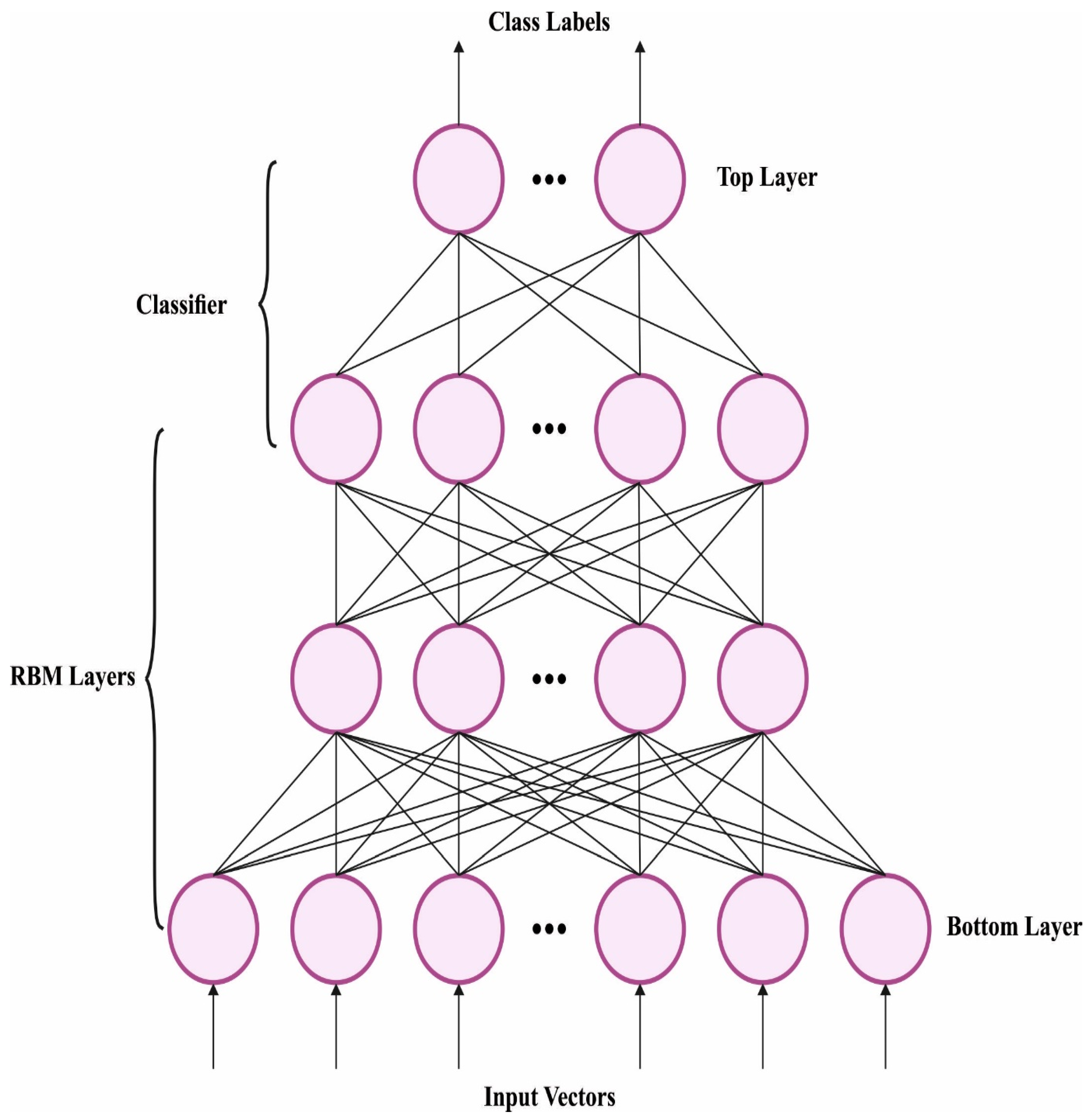

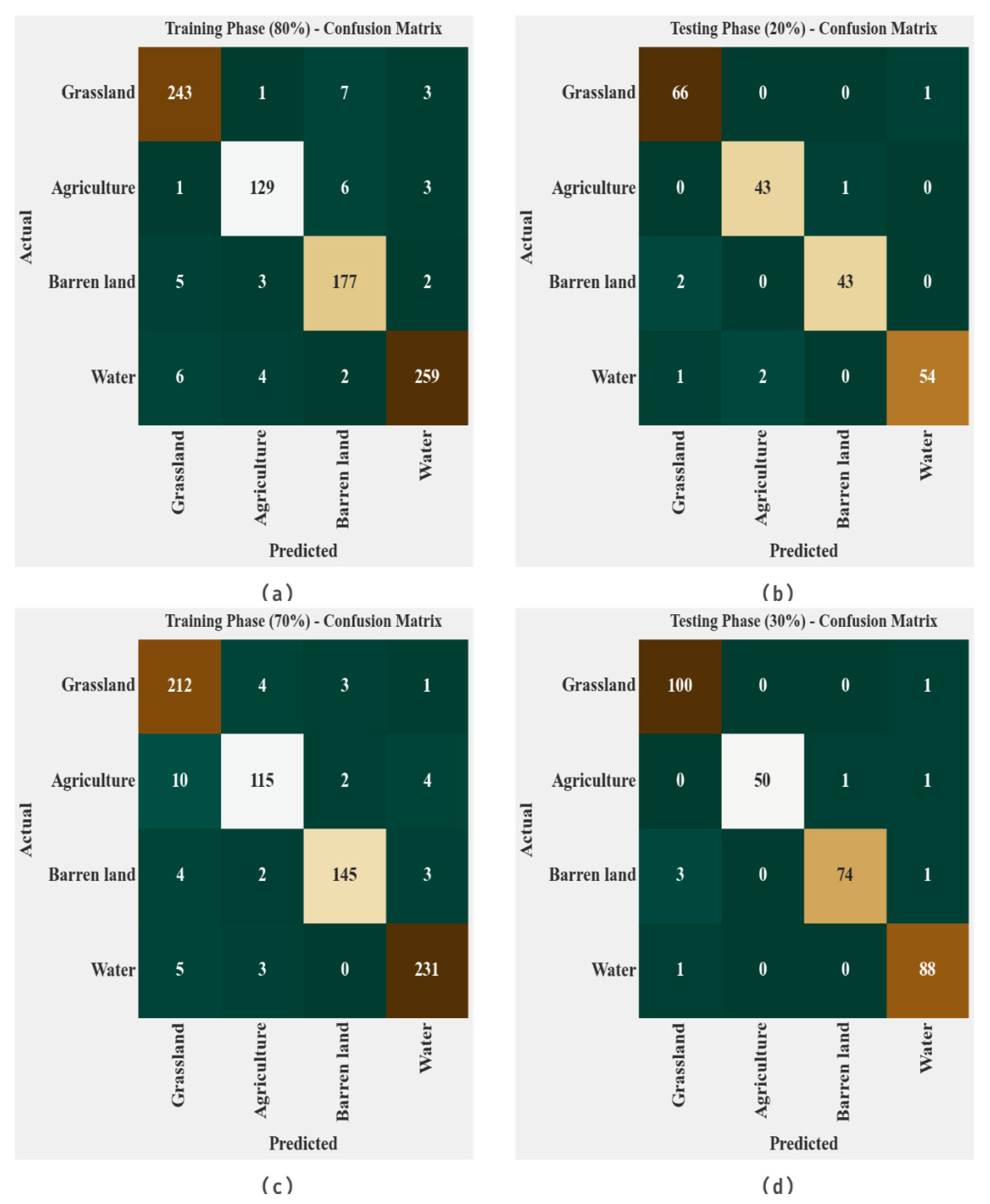

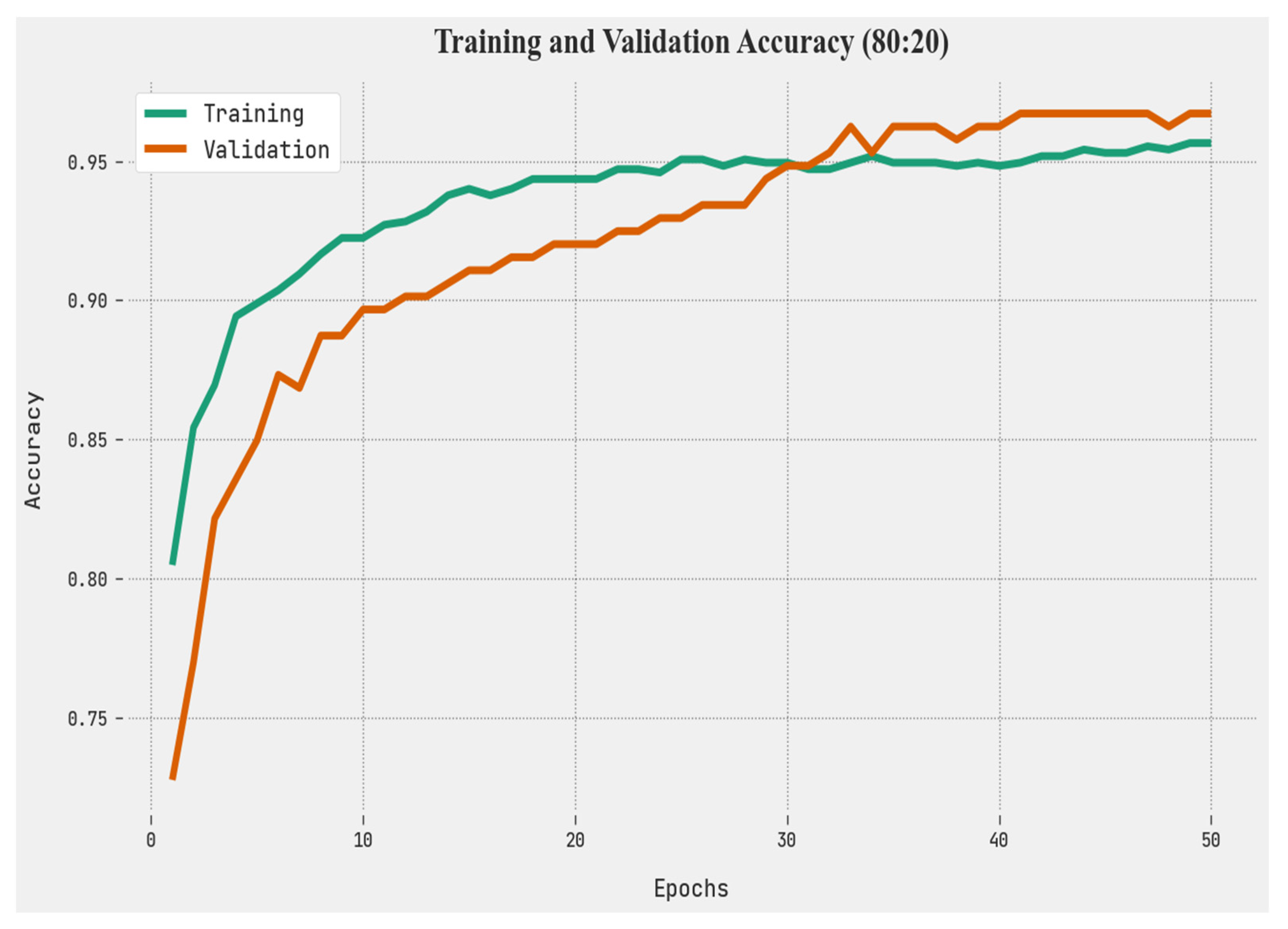







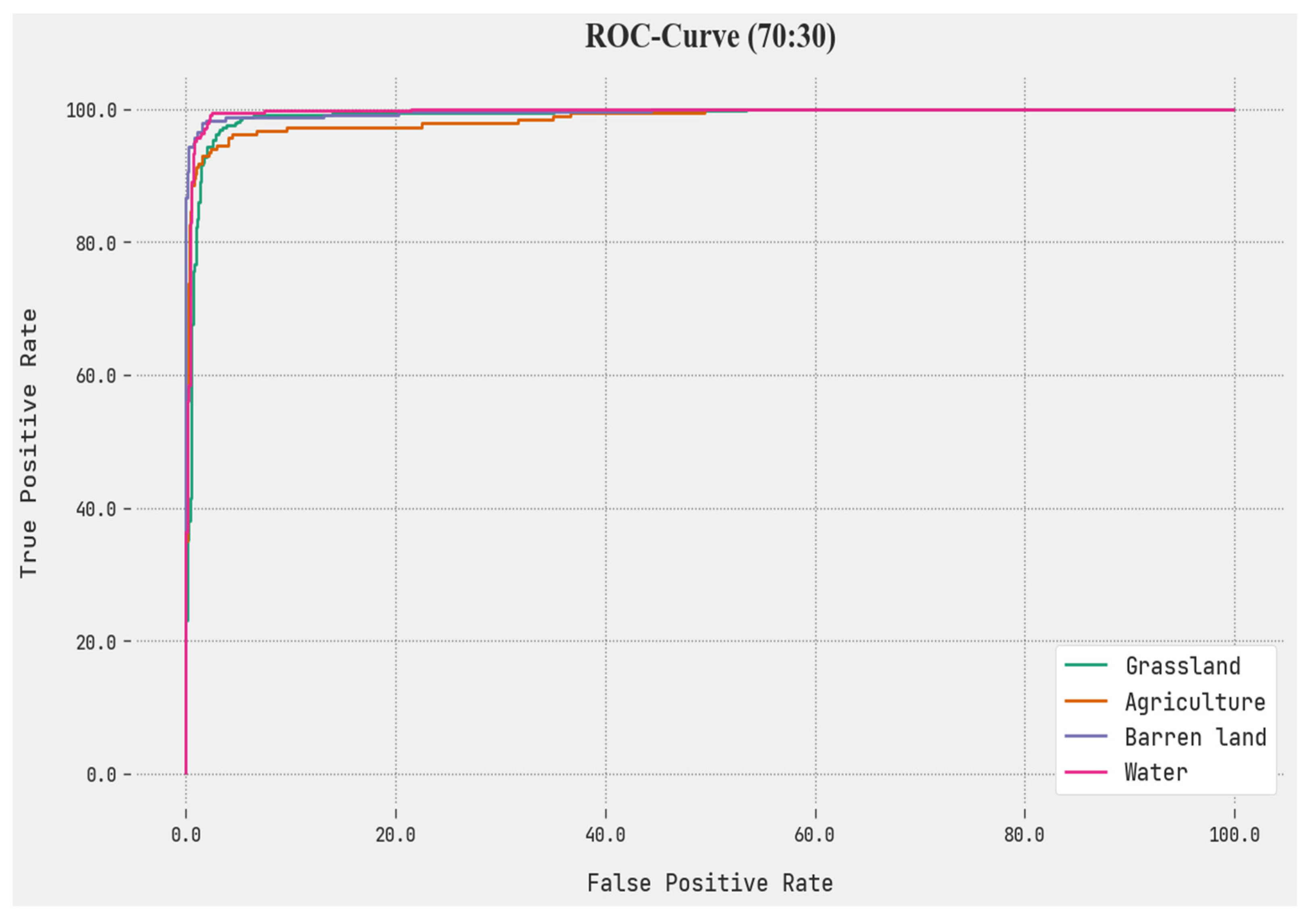


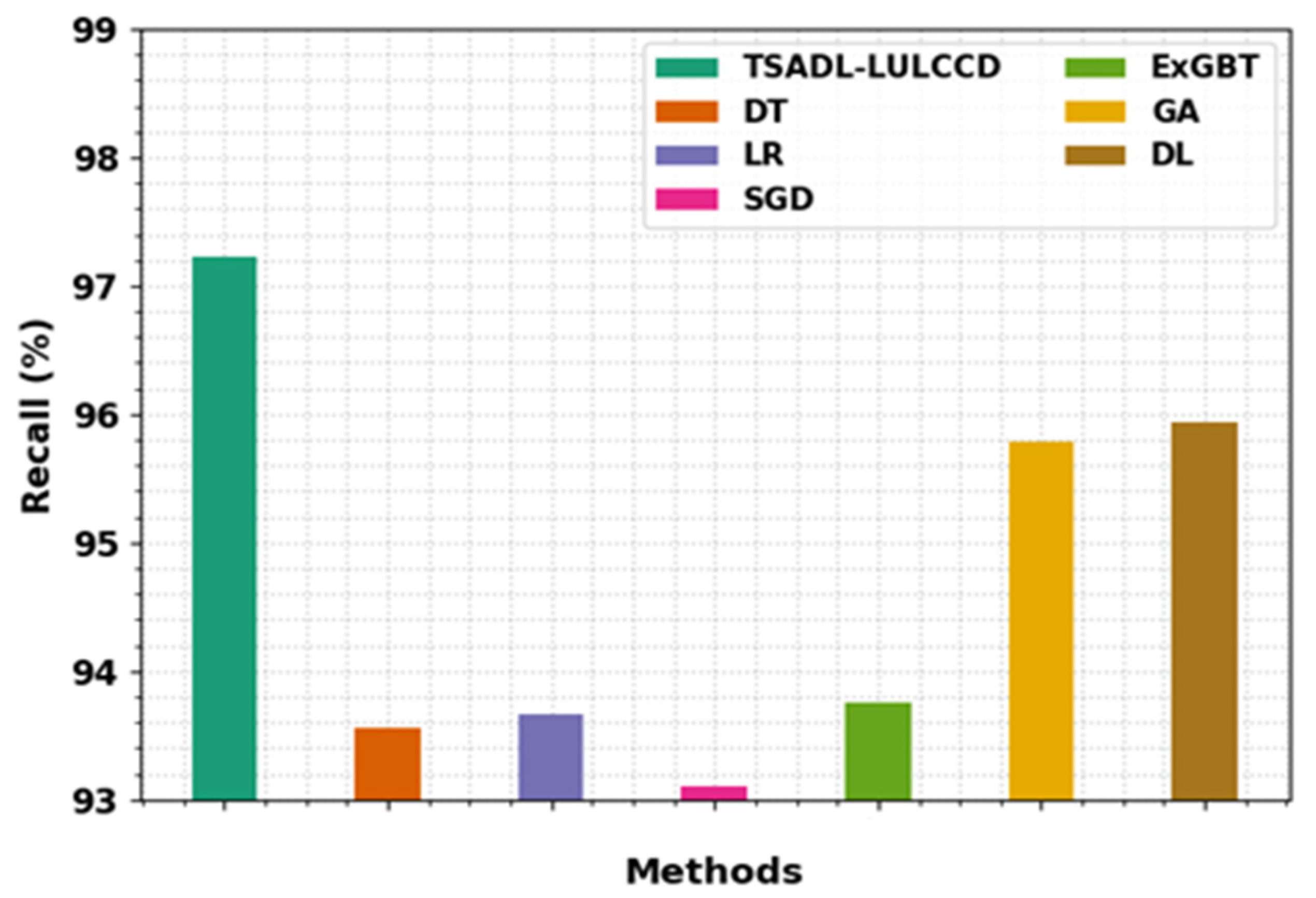

| Class | Area (km2) | Size | % of Area |
|---|---|---|---|
| Grassland | 321.30 | 321.00 | 30.20 |
| Agriculture | 182.90 | 183.00 | 17.19 |
| Barren land | 231.90 | 232.00 | 21.80 |
| Water | 327.70 | 328.00 | 30.80 |
| Total | 1063.80 | 1064.00 | 100.00 |
| Class | AUC Score | MCC | ||||
|---|---|---|---|---|---|---|
| Training Phase | ||||||
| Grassland | 97.30 | 95.29 | 95.67 | 95.48 | 96.83 | 93.55 |
| Agriculture | 97.88 | 94.16 | 92.81 | 93.48 | 95.84 | 92.22 |
| Barren land | 97.06 | 92.19 | 94.65 | 93.40 | 96.20 | 91.53 |
| Water | 97.65 | 97.00 | 95.57 | 96.28 | 97.10 | 94.57 |
| Average | 97.47 | 94.66 | 94.67 | 94.66 | 96.49 | 92.97 |
| Testing Phase | ||||||
| Grassland | 98.12 | 95.65 | 98.51 | 97.06 | 98.23 | 95.70 |
| Agriculture | 98.59 | 95.56 | 97.73 | 96.63 | 98.27 | 95.75 |
| Barren land | 98.59 | 97.73 | 95.56 | 96.63 | 97.48 | 95.75 |
| Water | 98.12 | 98.18 | 94.74 | 96.43 | 97.05 | 95.18 |
| Average | 98.36 | 96.78 | 96.63 | 96.69 | 97.76 | 95.60 |
| Training/Testing (70:30) | ||||||
|---|---|---|---|---|---|---|
| Classes | AUC Score | MCC | ||||
| Training Phase | ||||||
| Grassland | 96.37 | 91.77 | 96.36 | 94.01 | 96.37 | 91.47 |
| Agriculture | 96.64 | 92.74 | 87.79 | 90.20 | 93.16 | 88.22 |
| Barren land | 98.12 | 96.67 | 94.16 | 95.39 | 96.65 | 94.23 |
| Water | 97.85 | 96.65 | 96.65 | 96.65 | 97.53 | 95.07 |
| Average | 97.24 | 94.46 | 93.74 | 94.06 | 95.93 | 92.25 |
| Testing Phase | ||||||
| Grassland | 98.44 | 96.15 | 99.01 | 97.56 | 98.59 | 96.43 |
| Agriculture | 99.38 | 100.00 | 96.15 | 98.04 | 98.08 | 97.69 |
| Barren land | 98.44 | 98.67 | 94.87 | 96.73 | 97.23 | 95.74 |
| Water | 98.75 | 96.70 | 98.88 | 97.78 | 98.79 | 96.92 |
| Average | 98.75 | 97.88 | 97.23 | 97.53 | 98.17 | 96.70 |
| Algorithm | Average CPU Utilization (%) | Average GPU Utilization (%) | Time Taken (in ms) |
|---|---|---|---|
| TSADL-LULCCD | 71.3 | 21.1 | 353.176 |
| Stochastic Gradient Descent (SGD) | 27.3 | 50.6 | 150.577 |
| Symbolic ML via Genetic Algorithms (GA) | 33.5 | 40.7 | 268.784 |
| Methods | ||||
|---|---|---|---|---|
| TSADL-LULCCD | 98.75 | 97.88 | 97.23 | 97.53 |
| Decision Tree (DT) | 91.18 | 91.92 | 93.56 | 91.82 |
| Logistic Regression (LR) | 92.03 | 93.41 | 93.66 | 94.95 |
| Stochastic Gradient Descent (SGD) | 93.11 | 94.06 | 93.10 | 95.08 |
| Extreme Gradient Boosted Trees (ExGBT) | 93.13 | 96.42 | 93.75 | 95.98 |
| Symbolic ML via Genetic Algorithms (GA) | 95.24 | 95.75 | 95.79 | 95.88 |
| Deep Learning (DL) | 97.88 | 96.51 | 95.94 | 96.30 |
| Algorithm | Epoch | Iterations | RMSE | Log-Loss (%) | Validation Loss |
|---|---|---|---|---|---|
| TSADL-LULCCD | 10 | 150 | 87.86 | 31.51 | 0.30 |
| 20 | 300 | 66.76 | 29.88 | 0.32 | |
| 30 | 450 | 45.84 | 28.69 | 0.34 | |
| Stochastic Gradient Descent (SGD) | 10 | 150 | 88.17 | 31.59 | 0.49 |
| 20 | 300 | 67.51 | 29.96 | 0.47 | |
| 30 | 450 | 48.04 | 28.77 | 0.46 | |
| Symbolic ML via Genetic Algorithms (GA) | 10 | 150 | 89.33 | 31.44 | 0.52 |
| 20 | 300 | 67.93 | 29.80 | 0.53 | |
| 30 | 450 | 46.56 | 28.62 | 0.65 |
Disclaimer/Publisher’s Note: The statements, opinions and data contained in all publications are solely those of the individual author(s) and contributor(s) and not of MDPI and/or the editor(s). MDPI and/or the editor(s) disclaim responsibility for any injury to people or property resulting from any ideas, methods, instructions or products referred to in the content. |
© 2023 by the authors. Licensee MDPI, Basel, Switzerland. This article is an open access article distributed under the terms and conditions of the Creative Commons Attribution (CC BY) license (https://creativecommons.org/licenses/by/4.0/).
Share and Cite
Lavanya, K.; Mahendran, A.; Selvanambi, R.; Mazzara, M.; Hemanth, J.D. Tunicate Swarm Algorithm with Deep Learning Based Land Use and Cover Change Detection in Nallamalla Forest India. Appl. Sci. 2023, 13, 1173. https://doi.org/10.3390/app13021173
Lavanya K, Mahendran A, Selvanambi R, Mazzara M, Hemanth JD. Tunicate Swarm Algorithm with Deep Learning Based Land Use and Cover Change Detection in Nallamalla Forest India. Applied Sciences. 2023; 13(2):1173. https://doi.org/10.3390/app13021173
Chicago/Turabian StyleLavanya, K., Anand Mahendran, Ramani Selvanambi, Manuel Mazzara, and Jude D Hemanth. 2023. "Tunicate Swarm Algorithm with Deep Learning Based Land Use and Cover Change Detection in Nallamalla Forest India" Applied Sciences 13, no. 2: 1173. https://doi.org/10.3390/app13021173
APA StyleLavanya, K., Mahendran, A., Selvanambi, R., Mazzara, M., & Hemanth, J. D. (2023). Tunicate Swarm Algorithm with Deep Learning Based Land Use and Cover Change Detection in Nallamalla Forest India. Applied Sciences, 13(2), 1173. https://doi.org/10.3390/app13021173










